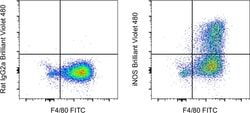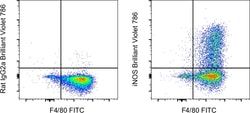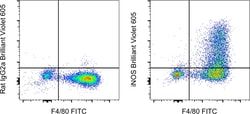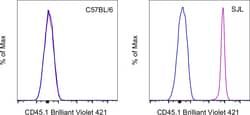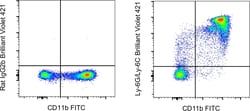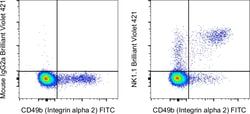iNOS Monoclonal Antibody (CXNFT), Brilliant Violet™ 421, eBioscience™, Invitrogen™
Manufacturer: Fischer Scientific
Select a Size
| Pack Size | SKU | Availability | Price |
|---|---|---|---|
| Each of 1 | 40-459-2082-Each-of-1 | In Stock | ₹ 31,328.00 |
40-459-2082 - Each of 1
In Stock
Quantity
1
Base Price: ₹ 31,328.00
GST (18%): ₹ 5,639.04
Total Price: ₹ 36,967.04
Antigen
iNOS
Classification
Monoclonal
Concentration
0.2 mg/mL
Formulation
PBS with BSA and 0.09% sodium azide; pH 7.2
Gene Accession No.
P29477
Gene Symbols
Nos2
Purification Method
Affinity chromatography
Regulatory Status
RUO
Gene ID (Entrez)
18126
Content And Storage
4° C, store in dark, DO NOT FREEZE!
Form
Liquid
Applications
Flow Cytometry
Clone
CXNFT
Conjugate
Brilliant Violet 421
Gene
Nos2
Gene Alias
Hepatocyte NOS; hepatocytes; HEP-NOS; inducible nitric oxide synthase; inducible NO synthase; Inducible NOS; iNos; i-NOS; Inosl; MAC-NOS; macrophage NOS; nitric oxide synthase 2; nitric oxide synthase 2, inducible; nitric oxide synthase 2, inducible, macrophage; nitric oxide synthase 2A (inducible, hepatocytes); nitric oxide synthase, inducible; nitric oxide synthase, macrophage; nitric oxide synthase-inducible; NOS; NOS type II; NOS, type II; Nos2; Nos-2; Nos2a; NOS-II; OTTMUSP00000000202; peptidyl-cysteine S-nitrosylase NOS2
Host Species
Rat
Quantity
100 μg
Primary or Secondary
Primary
Target Species
Mouse
Product Type
Antibody
Isotype
IgG2a κ
Description
- iNOS (Inducible Nitric oxide, NO, NOS) is an inorganic, gaseous free radical that carries a variety of messages between cells
- Vasorelaxation, neurotransmission and cytotoxicity can all be potentiated through cellular response to NO
- NO production is mediated by members of the nitric oxide synthase (NOS) family
- iNOS is expressed in liver and inducible by a combination of lipopolysaccharide and certain cytokines
- NOS catalyzes the oxidization of L-arginine to produce L-citrulline and NO
- Two constitutive isoforms, brain or neuronal NOS (b or nNOS, type I) and endothelial cell NOS (eNOS, type III), and one inducible isoform (iNOS, type II), have been cloned
- All NOS isoforms contain calmodulin, nicotinamide adenine dinucleotide phosphate (NADPH), flavin adenine dinucleotide (FAD), and flavin mononucleotide (FMN) binding domains
- iNOS is found in a variety of cell types including macrophages, hepatocytes, synoviocytes, and smooth muscle cells
- Cytokines such as interferon-gamma (IFN), tumor necrosis factor (TNF), interleukin-1 and -2, and lipopolysaccarides (LPS) cause an increase in iNOS mRNA, protein, and activity levels
- Protein kinase C-stimulating agents exhibit the same effect on iNOS activity
- After cytokine induction, iNOS exhibits a delayed activity response which is then followed by a significant increase in NO production over a long period of time
- Three related iNOS pseudogenes are located within the Smith-Magenis syndrome region on chromosome 17
- Diseases associated with iNOS dysfunction include achalasia and impotence.

